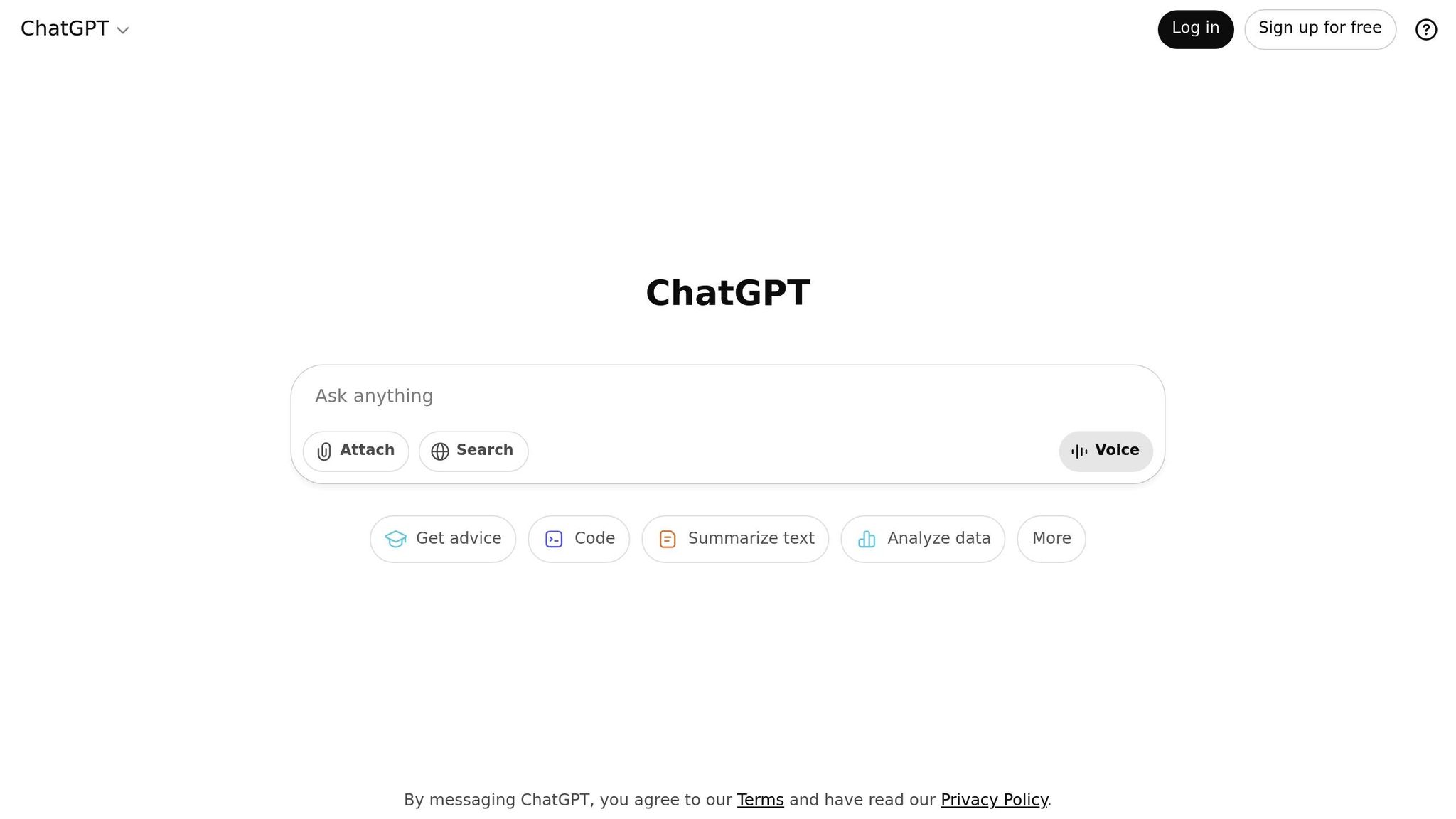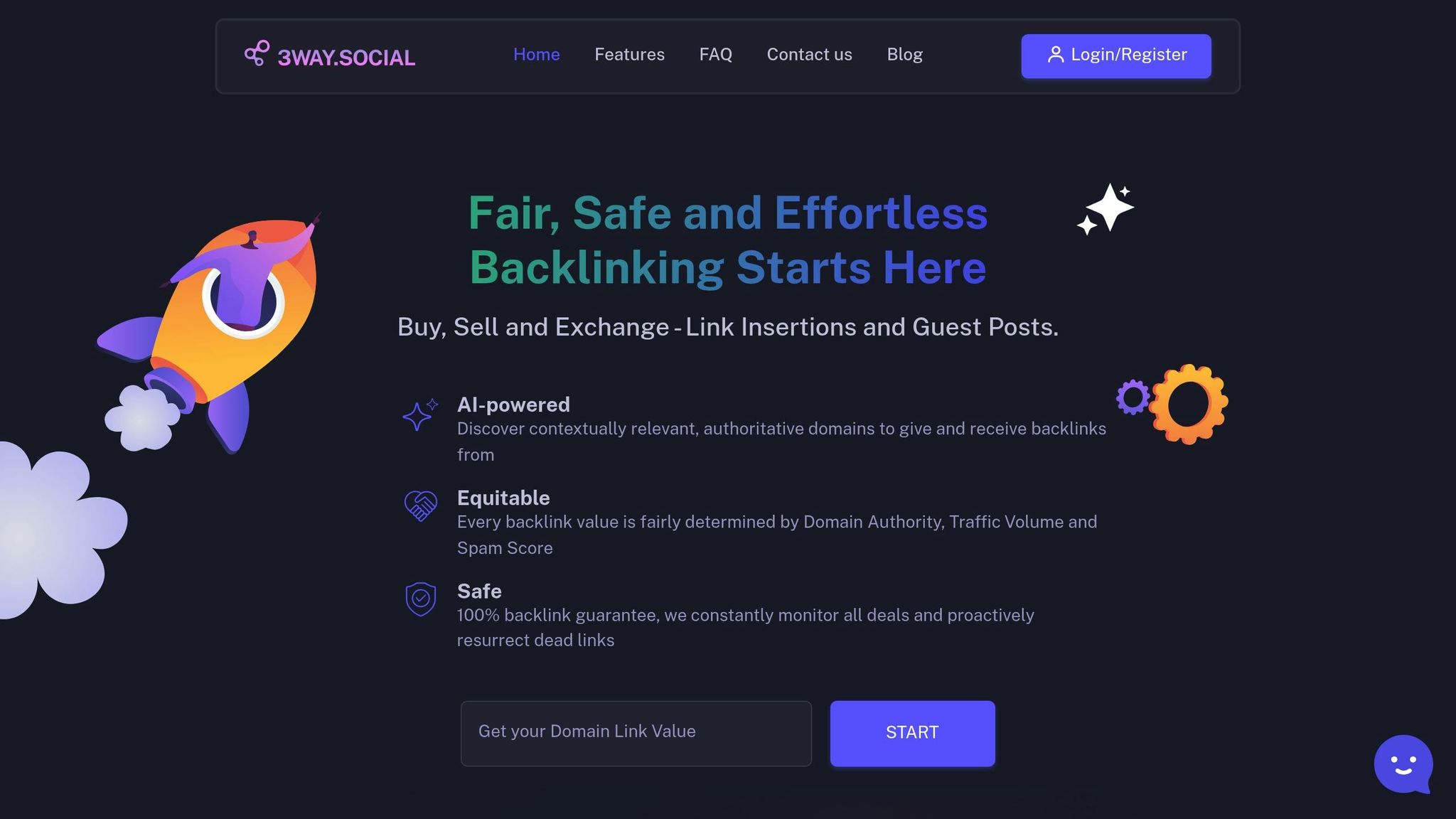Last Updated on July 21, 2025 by Becky Halls
AI has made backlink quality checks faster, more accurate, and scalable. This process, once manual and time-consuming, now relies on tools that analyze factors like domain authority, relevance, and spam signals in minutes. High-quality backlinks improve rankings and traffic, while toxic links harm SEO. AI identifies useful links, flags harmful ones, and even suggests new opportunities. Platforms like 3Way.Social simplify this process, combining automated analysis with human oversight for effective results. However, while AI saves time and improves precision, it still requires human input for nuanced decisions and quality control.
Use ChatGPT for Backlink Analysis and Visualization

Key Metrics Used in AI-Powered Backlink Quality Analysis
AI has reshaped how backlink quality is evaluated, relying on specific metrics to determine which links enhance SEO performance and which may harm it. These metrics help identify valuable backlinks that can improve your rankings while flagging harmful ones that could negatively impact your website. Understanding these metrics provides a clearer picture of how AI automates this critical process.
Domain Authority and Trust
Domain Authority (DA) is a key factor AI tools use to gauge backlink quality. It predicts a website’s ability to rank, with scores ranging from 1 to 100. AI assesses the DA of linking domains to evaluate their authority and reliability.
Moz‘s extensive dataset plays a crucial role in improving the accuracy of these evaluations. When analyzing DA, AI considers various elements, such as MozRank, MozTrust, social signals, the number of linking root domains, backlink profile health, user engagement, page load speed, and mobile usability. Alongside DA, AI also examines Page Authority (PA), which measures the ranking potential of individual pages.
“Moz is the only data source that gives real insights into link equity. Nothing on the market compares to Moz’s Domain Authority metrics, which we refer to constantly.” – Will Critchlow, Founder & CEO, SearchPilot
Spam scores are another critical metric in this process. A spam score below 30% is generally considered safe, and AI uses this data to spot potentially harmful domains that could hurt your SEO.
Relevance of Linking Site and Content
The relevance of a linking site’s content is another major factor in backlink value. AI goes beyond keywords to analyze the contextual relationship between the linking site and your content.
Take HubSpot, for example. When they used AI tools to refine their backlink profile, they prioritized high-quality links from authoritative domains in marketing and business. This strategy led to improved Domain Authority, increased organic traffic, and higher rankings for targeted keywords.
AI evaluates relevance by analyzing the content, context, and alignment of the linking page with your niche. Links from sites closely related to your industry carry far more weight than those from unrelated domains.
Anchor Text Analysis
Anchor text – the clickable text in a hyperlink – provides crucial signals about content relevance and trust. AI tools review anchor text patterns to ensure a balanced distribution, avoiding over-optimization. For example, exact-match anchors should make up no more than 10% to 15% of your total backlink profile, while keyword-rich anchors should stay within 10–30%. Maintaining this balance helps prevent penalties from search engines, especially since Google’s Penguin update targets unnatural linking patterns and excessive exact-match anchor use.
Toxic Link Detection and Risk Assessment
AI is highly effective at spotting harmful backlinks that could damage your rankings. It flags toxic links – often from link farms or irrelevant sites – by analyzing placement, tag attributes, and referral traffic metrics.
Traffic and engagement data provide additional layers of analysis. By examining these metrics, AI tools evaluate the potential referral traffic and user interaction each backlink could generate. Links from high-traffic, engaging sites are far more valuable than those from inactive or low-engagement domains.
This approach has proven effective for major brands. Moz, for instance, used its Link Explorer tool to clean up its backlink profile by identifying toxic links and acquiring high-quality ones from trusted SEO and marketing leaders. The result? A healthier backlink profile, stronger Domain Authority, and more organic traffic.
AI continuously monitors these metrics to ensure your backlink profile remains healthy. When toxic links are detected, it can recommend using tools like Google’s Disavow Tool to neutralize their impact. These metrics are the foundation for understanding how AI simplifies backlink quality management.
How AI Automates Backlink Quality Checks: Step-by-Step Process
AI has revolutionized backlink analysis, turning what was once a tedious, manual process into an efficient, automated workflow. By leveraging data and algorithms, it offers a detailed and time-saving approach to assessing backlink quality.
Data Collection and Processing
The process kicks off with AI tools gathering data from various sources. These tools compile information on traffic, engagement, content themes, and historical performance, creating a rich dataset for analysis.
Instead of just counting links, AI uses this data to provide deeper insights, identifying patterns and trends that would be difficult to spot manually.
Pattern Recognition and Analysis
Once the data is collected, AI algorithms take over to analyze linking patterns, anchor text distributions, and relationships between domains. They can even reveal competitors’ link-building strategies and detect unethical practices like link farms or unnatural spikes in backlinks.
By examining historical data, AI not only highlights current trends but also predicts future shifts in link-building strategies. This helps businesses stay ahead in the competitive SEO landscape.
AI’s ability to flag harmful tactics ensures that your backlink profile remains clean and compliant, protecting your site’s SEO performance.
Checking Link Quality and Relevance
With patterns identified, AI evaluates each backlink for its authority and relevance. It calculates authority scores for linking domains, assesses content relevance, and examines traffic quality to determine the SEO value of each link. This prioritization helps focus efforts on the most impactful opportunities.
AI goes a step further by analyzing the context of each backlink. It evaluates the linking site’s content themes, audience demographics, and engagement levels to determine whether search engines would view the link favorably. This goes beyond basic keyword matching, offering a more nuanced understanding of how the link fits with your site’s focus.
Finding New Link Opportunities
After cleaning up your backlink profile, AI shifts gears to identify new opportunities. By analyzing competitor backlinks, industry trends, and content gaps, AI tools suggest domains that align with your SEO goals. These recommendations are based on both quality and relevance, ensuring they fit your niche.
AI also uses historical data to predict the likelihood of successfully acquiring links, helping you prioritize outreach efforts. By tracking brand mentions and relevant keywords across the web, it continuously uncovers fresh opportunities.
Additionally, AI streamlines outreach by personalizing messages for each potential backlink. This tailored approach improves response rates and boosts the chances of securing high-quality links. From identifying prospects to managing outreach, AI ensures a seamless process for building a strong backlink profile.
Benefits and Drawbacks of Using AI for Backlink Quality Checks
AI has undoubtedly reshaped how backlink analysis is done, offering new possibilities for efficiency and precision. However, like any tool, it comes with both strengths and limitations that you need to weigh carefully before fully incorporating it into your SEO strategy.
Benefits: Speed, Scale, and Precision
One of AI’s standout advantages is its speed. Tasks that might take weeks or months with traditional methods can now be completed in just hours or days. This efficiency allows SEO teams to dedicate more time to crafting strategies rather than being bogged down by data crunching.
AI also handles scale like no other. With 86% of SEO professionals already employing AI in their workflows, it’s clear that the technology can process large datasets that would overwhelm human teams. For example, AI can evaluate thousands of backlink sources simultaneously, analyzing industry-wide factors without breaking a sweat.
Another key strength is precision. AI processes massive amounts of information with minimal errors, ensuring consistent analysis. Unlike humans, who may miss patterns after hours of work, AI maintains sharp focus throughout. It also has predictive capabilities, identifying future link-building opportunities by examining trends, past link performance, and data patterns. This forward-thinking approach can help businesses stay ahead of the curve.
“AI backlinks leverage artificial intelligence to streamline the process of acquiring high-quality backlinks, saving time and reducing manual efforts while enhancing SEO strategies.” – Ian Naylor, 3Way Social
On top of that, AI improves efficiency across marketing operations. Studies show it boosts productivity by 15%, translating to an annual savings of about $463 billion. For businesses, this means better resource allocation and a stronger return on investment in SEO.
Drawbacks: Missing the Human Touch
Despite its advantages, AI isn’t without its challenges. One of its biggest limitations is its struggle with nuanced contexts. AI might overlook promising opportunities that don’t fit rigid criteria, which can be a problem when assessing industry-specific relevance or subtle connections between brands and their audiences.
Another issue is quality control. AI tools sometimes misidentify low-quality websites as good backlink opportunities, leading to wasted time and potentially harming your site’s authority. This makes human oversight essential to ensure AI’s recommendations align with your goals.
Ethical concerns also come into play. AI can be misused for questionable tactics, like spamming comments on relevant sites. Without proper monitoring, these actions could violate search engine guidelines and damage your brand’s reputation.
Additionally, over-reliance on AI can reduce the critical human oversight needed for strategic decisions. Data privacy is another hurdle, with 58.64% of SEO professionals expressing concerns about security risks when using generative AI tools.
Comparison Table: Benefits vs. Drawbacks
Here’s a quick overview of AI’s strengths and limitations:
| Benefits | Drawbacks |
|---|---|
| Speeds up data processing | May overlook contextually important opportunities |
| Handles large datasets with ease | Can misidentify low-quality sites as good prospects |
| Delivers consistent and accurate analysis | Lacks creativity in evaluating prospects |
| Predicts future link-building opportunities | Prone to unethical use, like spamming |
| Boosts marketing productivity by 15% | Requires human oversight to ensure quality |
| Automates repetitive tasks | Raises concerns about data privacy and security |
The key takeaway? AI shines when it comes to automating repetitive, data-heavy tasks, but it’s not a one-size-fits-all solution. While 67% of SEO professionals see automation as AI’s biggest strength, 65.14% worry about issues like content quality and authenticity when relying on generative AI. The best results come from combining AI’s efficiency with human judgment to ensure strategic decisions and quality control remain intact.
Using 3Way.Social for AI-Driven Backlink Quality and Link Building

3Way.Social brings AI into the mix for backlink quality checks and link building, making these traditionally time-consuming tasks faster and more precise. By integrating AI’s capabilities into your SEO workflow, the platform simplifies backlink assessment and enhances your link-building efforts.
Key Features of 3Way.Social
3Way.Social uses AI to connect your website with contextually relevant and authoritative domains. Through its ABC link exchange system, it matches you with ideal partners, creating a natural backlink profile that mimics the organic linking patterns seen across the web. The platform’s advanced domain-matching tools analyze your site’s niche, authority, and content themes, ensuring partnerships align with relevance and quality standards – saving you countless hours of manual research.
Additionally, 3Way.Social offers permanent do-follow links and provides ongoing monitoring. It keeps an eye on all deals and even revives broken links, backing this service with a 100% backlink guarantee.
Simplifying Backlink Quality Checks with 3Way.Social
With AI at its core, 3Way.Social evaluates potential link partners using key metrics like Domain Authority, Traffic Volume, and Spam Score – removing the need for manual vetting. Its unified SEO score system ensures transparency by calculating the fair market value for each link. Precision filtering also allows you to set specific criteria, combining automation’s speed with the insights of human oversight.
Improving SEO Strategies with 3Way.Social
The platform has delivered impressive results for users, including up to a 20% increase in traffic, rankings achieved three times faster, and a 30% boost in Domain Authority. With over 10,000 successful link exchanges, 3Way.Social’s vetted network of SEO professionals ensures that AI-driven assessments are supported by human expertise, enhancing the credibility of your link partners.
“3Way.Social revolutionized our SEO approach. Our site’s rankings have significantly improved thanks to its innovative ABC link exchange system. The platform’s high-quality partner network is unmatched.”
– Sophia Martinez, SEO Manager
“This platform has been a lifesaver for my link-building campaigns. The user-friendly dashboard and smart exchange options save me countless hours, and the precise partner selection based on SEO metrics is a major plus.”
– Alex Chen, Freelance SEO Consultant
3Way.Social also offers flexible link-building options, including ABC exchanges, niche edits, and guest posts. These features allow you to tailor your strategy, building a diverse backlink profile that search engines favor. The platform’s intuitive dashboard simplifies managing multiple partnerships, making AI-powered link building accessible for teams of all experience levels. By combining automation with human expertise, 3Way.Social transforms link building into a streamlined process that directly boosts SEO performance.
Conclusion: The Future of Backlink Quality Analysis with AI
AI is revolutionizing backlink analysis, turning what was once a tedious, manual task into a streamlined, data-driven process. As Ciaran Connolly, Founder of ProfileTree, explains:
“AI is not just a tool; it’s a game changer in link building, allowing us to execute strategies with precision that was once impossible manually”.
This transformation is happening at a time when competition for online visibility is fiercer than ever. With Google handling 14 billion searches daily as of 2024, businesses need smarter tools to stay ahead. AI-driven backlink analysis uses machine learning to evaluate a wider range of factors, predicting the impact of links on search rankings more effectively.
A major trend shaping SEO is intent-based optimization. AI tools are moving beyond basic keyword analysis to understand user intent and the context behind searches. This shift allows for more accurate targeting and better content strategies.
For companies aiming to remain competitive, integrating AI-powered tools is becoming a necessity. By 2025, the global AI market is expected to reach $243.72 billion, and projections suggest it will grow to $826.73 billion by 2030. Businesses already using AI report a 66% boost in productivity, showcasing the real-world advantages of automation.
However, success lies in blending AI with human expertise. Albert Badalyan, an SEO Strategist, emphasizes this balance:
“Nowadays, SEO is more than just a chess game with keywords and backlinks – it’s become more efficient, accurate and personalized for optimal results when implemented correctly with AI”.
Platforms like 3Way.Social illustrate this hybrid approach, combining AI’s ability to automate complex processes with human oversight from experienced SEO professionals. This ensures quality while leveraging the speed and scale of AI.
Looking ahead, predictive analytics will play a key role in identifying link-building opportunities and forecasting long-term performance. AI will also expand cross-platform insights, pulling data from forums, social media, and other diverse sources.
To thrive in this evolving landscape, businesses should focus on creating intent-driven content, auditing backlinks for potential risks, and keeping an eye on competitors. Gradual integration of AI tools can help companies stay ahead while adapting to ongoing advancements.
The shift is already underway. Companies that embrace AI-powered backlink analysis today are positioning themselves to lead in tomorrow’s search rankings.
FAQs
How does AI identify high-quality backlinks and detect harmful ones in SEO?
AI examines backlinks by looking at factors like domain authority, content relevance, and spam signals. Quality backlinks usually originate from trusted websites with content that aligns well with your own, while harmful backlinks often show traits like low domain authority or unnatural linking patterns.
With automation, AI tools can quickly identify toxic links that could damage your site’s SEO and pinpoint high-value links that boost your rankings and strengthen domain authority.
Why is human oversight important in AI-driven backlink quality checks?
Human involvement is key when it comes to AI-powered backlink quality checks, ensuring accuracy, relevance, and upholding strong standards. While AI excels at analyzing data and spotting patterns, it often falls short in understanding the context behind a backlink’s quality or intent.
By integrating periodic manual reviews, people can identify subtle issues – like sneaky spam techniques or off-topic links – that automated tools might overlook. This blend of AI’s speed and human insight helps protect your site from poor-quality or harmful backlinks, keeping your SEO strategy on track and in line with best practices.
How can businesses use AI tools like 3Way.Social to enhance their link-building strategies?
Businesses can use AI-powered platforms like 3Way.Social to make their link-building efforts more efficient and effective. This tool automates key tasks such as evaluating backlink quality, matching domains, and diversifying links, ensuring the links are secure, high-quality, and optimized to improve SEO results.
With its AI-driven approach, 3Way.Social simplifies the process of generating permanent do-follow links while connecting users to a trusted network of SEO experts. This not only saves valuable time but also boosts website rankings, increases traffic, and strengthens domain authority – making it a smart addition to any modern SEO plan.



